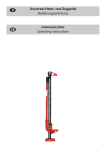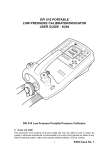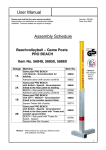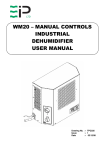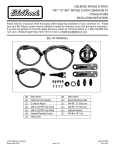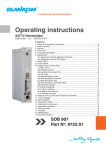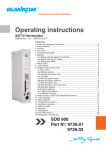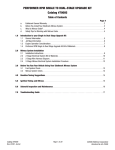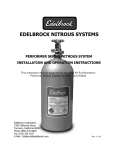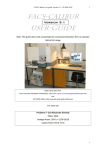Download Edelbrock 71884 Automobile Parts User Manual
Transcript
EDELBROCK NITROUS SYSTEMS “WET” TO “DRY” NITROUS SYSTEM CONVERSION KIT CATALOG #71884 INSTALLATION INSTRUCTIONS Please read this instruction sheet thoroughly before beginning installation of your conversion kit. Please have your DRY Nitrous System manual available if needed for reference at any time during this installation. If you have any questions or comments, please feel free to contact our Technical Hotline at: 1-800-416-8628 from 7a.m.-5p.m., Monday through Friday, Pacific Time or e-mail us at [email protected]. PLEASE complete and mail your warranty card. Be sure to write the model number of this product in the "Part #____" space. THANK YOU. BILL OF MATERIALS Qty. ❑1 ❑1 ❑1 ❑1 ❑4 ❑2 ❑1 ❑5 ❑1 ©2005 Edelbrock Corporation Brochure #63-0434 Description Performer Nitrous Solenoid Dry Nitrous Nozzle 50PSI Adjustable Hobbs Switch 1/8”NPT Brass Nipple Solenoid Mounting Screws Various Jets 4AN - 1/8”NPT Filter Fitting Ratchet Hose Clamps EFI Vacuum Tee Qty. ❑1 ❑1 ❑1 ❑1 ❑1 ❑1 ❑ 3ft ❑1 ❑3 Page 1 of 4 Description Nozzle Mounting Collar 1/8”NPT Pipe Plug 90° 4AN Swivel Adapter EFI Solenoid Bracket Solenoid Tee 1/8”NPT Hose Barb 3/16” Hose Nitrous Pressure Regulator Ring Terminals Catalog #71884 Rev. 12/05 - DC/mc INSTALLATION INSTRUCTIONS WET COMPONENTS INSTALLATION WARNING!!! Before performing any of these steps, turn off the bottle valve and purge the nitrous system of pressure as well as disconnect the battery. Failure to do so may cause engine damage and/or personal injury. DRY COMPONENTS REMOVAL 1. Remove the 3AN nitrous line and 3AN fuel line currently installed leading from the solenoids to the wet nitrous nozzle. 2. Remove the wet nitrous nozzle and installed jets from the nozzle collar. Leave the nozzle collar in place, but plug using the supplied 1/8” NPT Pipe Plug. Be sure to use Teflon Paste on the threads of the pipe plug. 3. Disconnect the 4AN feed line from the nitrous solenoid. Leave the line in place since this line will be used for the dry system as well. 4. Disconnect the positive solenoid wires from the blue wire coming from the relay wiring harness. 5. Disconnect the ground wires from the solenoids. Make sure that you do not damage the ring terminal on the nitrous solenoid because this ground will be re-used when the solenoid is re-installed. 6. Disconnect the fuel solenoid supply hose from wherever the hose was connected (Usually the test port on the fuel rail). 7. Install the Fuel Pressure Safety Switch (Hobbs Switch) in the fitting or port where your wet nitrous system was getting fuel from (The port or fitting referred to in step 6). 7. Remove the nitrous and fuel solenoids and brackets from the engine compartment. Be sure to ALWAYS use Teflon Paste, not Teflon Tape, on ALL pipe threads unless directed not to. 1. Using a 7/16” drill bit, drill a hole in the intake boot next to where the wet nozzle collar is mounted. This new hole will be where you install the dry nozzle collar. Once the hole is drilled, be sure to clean out any shavings, and install the new nut and collar in this hole. Note the taper in the collar and be sure to install with this taper facing into the intake boot so the nozzle can be installed correctly. Tighten the nut onto the collar securely and then install the dry nozzle into the collar. Tighten securely, making sure that the nozzle outlet is facing into the intake manifold. 2. Take the Performer Nitrous Solenoid you are going to re-use and remove the outlet fitting. Install the steel tee fitting into the outlet of the solenoid, with the tee female port facing down. 3. Install the blue 3AN to 1/8” NPT fitting you just removed into the OUTLET side of the NEW Performer Nitrous Solenoid. 4. Install the remaining male port of the tee of the solenoid assembly into the inlet port of the NEW Performer Nitrous Solenoid. 5. Install the 1/8” NPT nipple into the female port of the tee of the solenoid assembly. 6. Install the Nitrous Pressure Regulator onto the 1/8” NPT nipple. 7. Install the 1/8” NPT to Barb fitting into the side port of the Nitrous Pressure Regulator. 8. Install the EFI solenoid bracket to the solenoid assembly using the supplied solenoid mounting screws. This concludes the removal and disassembly of the wet nitrous system. From this point on, we will be installing components for the dry nitrous system. This includes using both the new components that are supplied with this kit, as well as re-using certain components that were supplied with your wet nitrous system such as the nitrous solenoid and the previous nitrous system wiring. ©2005 Edelbrock Corporation Brochure #63-0434 Page 2 of 4 The assembly should now look like what is pictured here. Catalog #71884 Rev. 12/05 - DC/mc 9. Find a secure location to mount the Performer Nitrous Solenoid assembly within reach of the nitrous feed line and the dry nitrous nozzle. Make sure that this location is away from moving objects and will not interfere with closure of the hood. 10. Connect the nitrous feed line to the INLET fitting of the Performer Nitrous Solenoid. DO NOT use any thread sealant, since AN fittings are designed as dry seal fittings. 11. Using your existing blue 3AN line, connect one end of the line to the OUTLET fitting on the Performer Nitrous Solenoid. 12. Place the .032” nitrous jet in the EFI nitrous nozzle. Attached the free end of the blue 3AN line to this fitting with the jet in place. DO NOT use any type of thread sealant for this connection. 13. Take the new EFI Vacuum Tee that is supplied with this kit, and make sure that the .042” jet is installed. 14. Remove the vacuum line from the vehicles fuel pressure regulator. Install this line on the center barb of the EFI Vacuum Tee. (NOTE: The center barb can easily be identified by the anodized nut used to hold the Fuel Jet.) 15. Measure the correct length of vacuum line from the barb on the Fuel Pressure Regulator to one port of the EFI Vacuum Tee. Cut the vacuum line and install. 16. Measure the correct length of vacuum line from the barb fitting to the nitrous pressure regulator to the remaining open port of the EFI vacuum tee. Cut vacuum line and install. This concludes the installation of the hardware for your Dry Nitrous System. After performing these steps, it is time to do a pressure check on all of the components that you just installed before completing the system wiring. You should check the nitrous system. This should be checked with the engine OFF. Make sure that all fittings are tight. Slowly open the bottle valve and walk back around to the engine compartment. Listen carefully for leaks. Leaks can be noticed by a slight hissing sound or by ice forming around fittings. You should hear no sounds coming from fittings or lines if everything is connected properly. If leaks are noticed, tighten the fittings until the leaks seal. ©2005 Edelbrock Corporation Brochure #63-0434 FINAL WIRING 1. Connect one wire from each solenoid to the BLUE wire routed from the relay wiring harness. 2. Ground the inlet solenoid (the nitrous solenoid that the feed line leads into) directly to a chassis ground. 3. Connect the remaining wire from the outlet solenoid (the nitrous solenoid that feeds the nozzle) to the fuel pressure safety switch. 4. Connect a wire from the remaining terminal of the fuel pressure safety switch to a chassis ground. Your Wiring Should Look Like This.. Fuel Pressure Safety Switch Ground Second Nitrous Solenoid First Nitrous Solenoid To BLUE wire from harness Ground The purpose of the Fuel Pressure Safety Switch is to prevent the safety solenoid (second solenoid in line) from opening and filling the manifold with nitrous without adequate fuel pressure. This switch monitors the fuel pressure and only actuates over a pre-set fuel pressure. To test the wiring of your Performer Nitrous Solenoids, make sure that the bottle valve is in the “OFF” position. Turn the ignition key to the “ACC.” position. Use a jumper to connect the two terminals of the fuel pressure safety switch, therby bypassing the fuel pressure safety switch. With the arming switch in the “ON” position, quickly tap the microswitch button to activate the system. You should hear the first solenoid “click” if wired correctly. Make sure that you perform this test with the valve OFF to prevent filling the manifold with Nitrous Oxide. Be sure to remove the jumper from the fuel pressure safety switch once done testing the wiring. Page 3 of 4 Catalog #71884 Rev. 12/05 - DC/mc JET MAP INFORMATION Edelbrock Engineering has conducted extensive dyno testing with the Edelbrock Dry Nitrous System on various vehicles to ensure the horsepower increase with the nitrous system is safe and functions as intended. On a typically stock 1.5L to 2.0L, you can expect the following approximate horsepower gain: Nitrous Jetting .032 Fuel Jetting .042 Approx. HP Gains 50hp NOTE: This jet map is intended to be used on a vehicle running approximately 40 psi fuel pressure. On an engine of greater displacement, horsepower gains may be slightly different. ENGINE OPERATIONS CONSIDERATIONS: When used correctly, nitrous oxide safely elevates cylinder pressures and temperatures while increasing combustion rate. These characteristics make the engine more sensitive to detonation. To ensure proper performance, engine and drive line life, the following tips are suggested: System Jetting Never exceed the recommended jetting! jetting can result in sever engine damage. Excessive Fuel Quality Because Nitrous Oxide is an oxidizer, fuel selection is critical. Both octane and fuel consistency affect fuel burn rate. The oxidizer quality of Nitrous Oxide will accelerate the burn rate, so we recommend a high quality of gasoline. We also recommend you use the same grade of gasoline every time you use your Nitrous Oxide system. This will help to maintain the same fuel burn rate every time. Ignition Components Most aftermarket performance chips increase the vehicle’s ignition timing, which can cause detonation with the use of Nitrous Oxide. Please consult with your chip manufacturer on information regarding the compatibility of your chip with Nitrous Oxide use. Many power programmers function using the same method. Contact your power programmer manufacturer concerning the use of Nitrous Oxide as well. Many power programmer manufacturers have specific programs for Nitrous Oxide use. If your vehicle is equipped with platinum type spark plugs, we highly recommend they be removed and replaced with the equivalent stardard-type spark plug. Engine System Upgrades With all performance modifications, complementary system upgrades will always serve to elevate the consistency and longevity of an engine, especially when using Nitrous Oxide as a power adder. Modifications such as ignition upgrades, free-flowing exhaust, camshafts, cylinder heads, and manifolds can all add to the performance of a Nitrous Oxide injected engine. Edelbrock Corporation • 2700 California St. • Torrance, CA 90503 Tech-Line: 800-416-8628 E-Mail: [email protected] ©2005 Edelbrock Corporation Brochure #63-0434 Page 4 of 4 Catalog #71884 Rev. 12/05 - DC/mc




